The Museum Collections
Introduction
I. History and Art Collection
1. Icons of the 14th – 19th centuries
icons of the 14th – 17th century
2. Jewelry art of the 14th – 20th century
jewelry art of the 14th – 17th century
jewelry art of the 18th – 19th century
the european silver 14th - 19th centuries
3. Small-size sculptures (works of metal, wood, bone)
XI – the beginning of the XX century
Small-size sculptures 11th – 17th century
Small-size sculptures 18th – early 20th century
enamel of Troitza masters 15-8th – early 20th century
5.Embroidery, lace, textiles of the 14th - early 20th century
icon and ornamental embroidery
gold and silver lace
6.Painting of the 18th – 21st centuries
painting of the 18th – 19th centuris
painting of the 20th – 21st centuris
II.Manuscripts and old printed books of the 14th – 17th century
IV.Lithography of the 18th – 19th century
V.Numismatics
VI.Medals of the 18th - early 20th century
VIII.Archeology collection
IX. Russian folk and applied and decorative art of the 17th – 21st c.
1. Artistic wood
folk carved and painted wood
wooden toys
house carving of Sergiev Posad
Khokhloma and Gorodets painting
2. Artistic textiles
embroidery and weaving
printed textiles and lace
Russian shawls
folk costumes
folk garments
printed cotton kerchiefs
|
Icon and Ornamental Embroidery of the 14th – 19th Centuries (p. 1)
|
An important place in the Museum collection is occupied by the I5th - I7th century embroidery. Compared with the similar col¬lections in our country it is not large (200 odd items). But its historic and artistic value is actually unsurpassed. Based on the col¬lection of the Trinity-St. Sergius Monastery, it comprises reliab¬ly recorded and signed works, connected with the leading Moscow work¬shops reflecting the development of this art in the course of three centuries. The collection presents various figurative and ornamental compositions embroidered in multi-colored silks, gold and silver thread and pearls. It acquaints with an original sphere of Russian medieval art, which had much in common with icon-painting and folk art.
The embroidered items were greatly appreciated and carefully preserved. They were frequent donations to the major monasteries. Works of art: icon-cloths, palls and shrouds, icons, ancient books and church vessels of precious metals alongside with land and money - were donated to the Trinity-St. Sergius Monastery. The embroideries were produced in special workshops. Well-trained needlewomen worked there. The workshop was usually supervised by the lady of the house – boyarynia, princess, tsarina, who was often a skilful embroiderer herself. Since the I5th century the leading place belonged to the Grand .Prince workshops, which since the mid-l6th century were called "tsarina's chambers''. The collection of icon-embroidery of the first half of the 15th - early 16th century is most comprehensive . It was the time when icon-painting flourished in Russia as the result of general revival of Russian lands. Icon-painting led to the reinforcement of pictorial na¬ture in embroidery as well.
Icon Embroidery
Works of icon-embroidery: various icon-cloths, large and small shrouds, burial palls, covers for church vessels - present an important part of the display. The 15th century items are not numerous, so the specimens of the Sergiev Posad Museum are worthy of special consideration. They supplement information of the 15th century icon-painting mainly known since the time of Andrei Rublev and Dionysius – the leading painters of Moscow artistic school at the beginning and at the end of the 15th century.
The monuments of the first half of the I5th and early I6th century are most valuable. It was the time when icon-painting flourished in Russia. It led to the reinforcement of pictorial nature in embroidery as well. But other materials and techniques made the embroidered items very special. Stitched in multi-colored silks and gold and silver threads on textiles of selected color and texture, embroideries were always impressively decorative. The earliest specimen in the collection dates back to the early I5th century. It is the shroud depicting "The En¬tombment". The main work of the 15th century Moscow embroidery is the pall "St. Sergius of Radonezh" which was obvious¬ly created for canonization of the Trinity Father Superior in 1422. Quite a group of small icon-cloths, depicting different Christian feasts, is referred to the first half of the 15th century.
|
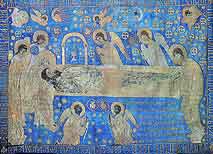
Shroud. The Entombment. Early 15th century. |
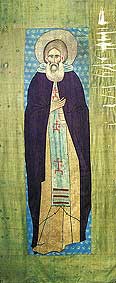
St. Sergius of Radonezh. Pall. 1420s. |
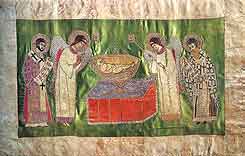
“Agnus Dei”. Aer. The first half of the 15th century.
|
The 15th century embroideries can be described as specimens of picturesque style. Their expressiveness was achieved with the help of local colors of silk threads covering certain surfaces like paints. Sometimes they used different shades of the same color to model figures. Besides, needlewomen used special techniques: the so-called “satin” stitch and the “stem” stitch breaking the thread of the previous stitch with a needle, that made embroidery thick and durable.
Three small works: “The Crucifixion and Selected Saints”, “The Trinity and Church Feasts” and “ The Burial of St. Anna” - are remarkable samples of the mid-15th century. The purificator depicting “The Crucifixion and Selected Saints” was probably embroidered in the Grand Prince workshop. The designer of “ The Trinity and Church Feasts” was evidently impressed by the images of Andrei Rublev. All items demonstrate the needlewomen’s refine artistic taste. Embroidery in multi-colored silks is perfectly combined with the fine texture of silk taffeta. Gold threads made it even more exquisite.
|
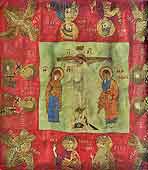
The Crucifixion and Selected Saints. Purificator. Mid-15th century |
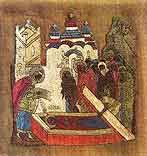
The Burial of St. Anna. Icon-cloth. Second half of the 15th century |
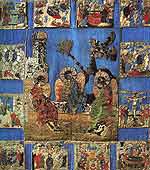
The Trinity of Old Testament And Church Feasts. Purificator. Second half of the 15th century
|
|
The late 15th and the first quarter of the 16th century are represented by a number of outstanding specimens. Among them there are widely known and precisely dated works of the Grand Prince workshops, as well as, anonymous masterpieces of the Moscow boyars’ and service men’s workshops. These samples show the evolution of embroidery that carefully preserved the best traditions of the previous period. We can trace more gold and silver threads, more pearls and precious stones in them. They demonstrate accomplished technique of stitching. Some embroideries are perceived not only like paintings, but also like decorative and precious items. Gold, silver and precious stones conformed with the artistic conceptions.
|
|


